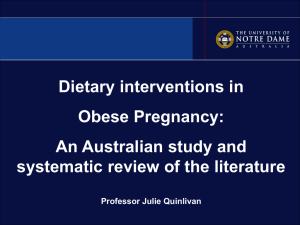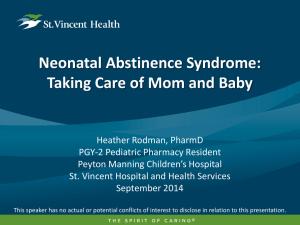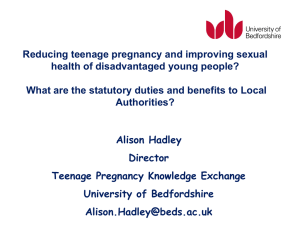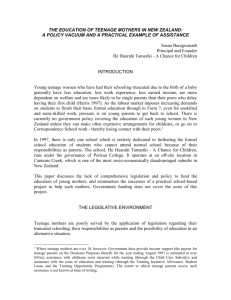Beyond the numbers: Understanding potentially avoidable deaths
advertisement
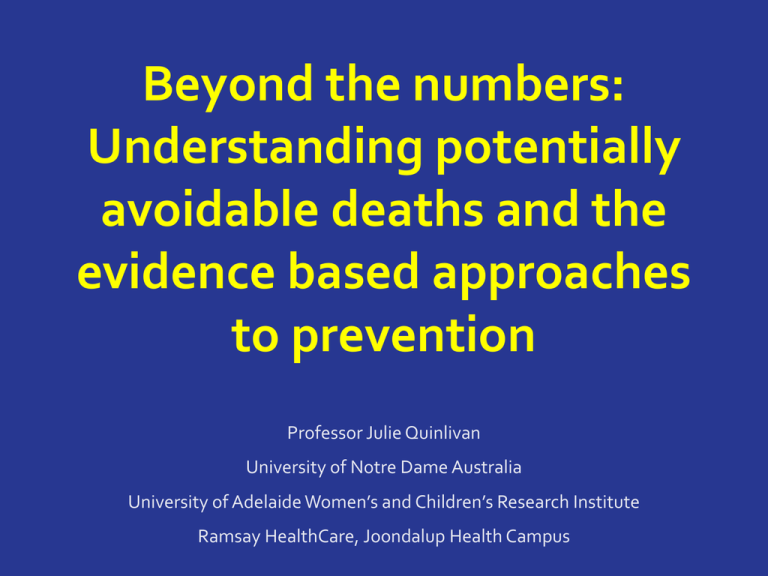
Beyond the numbers: Understanding potentially avoidable deaths and the evidence based approaches to prevention Professor Julie Quinlivan University of Notre Dame Australia University of Adelaide Women’s and Children’s Research Institute Ramsay HealthCare, Joondalup Health Campus Acknowledgements • Members of the Perinatal and Maternal Mortality Review Committee • Chair, Professor Cynthia Farquhar • Health Quality and Safety Commission New Zealand. Perinatal mortality • Key associations • Potentially avoidable factors • Evidence that may guide a response Associations with Ethnicity • Maori and Pacific women – Still birth – Preterm birth – Antepartum haemorrhage – Sudden Unexpected Deaths in Infancy • NZ European and non-Indian Asian women – Neonatal deaths – Hypertension and diabetes Associations with Socioeconomic Deprivation Increased stillbirth Increased neonatal death Associations with Age * Teenage mothers – Stillbirth – NND – Preterm birth * Older mothers (>40 years) – Maternal medical conditions – Congenital abnormalities Associations with Drug and Alcohol Use • Smoking – Data still incompletely reported (50%) – 35-29% deaths compared to background rate of 14% • Alcohol and marijuana – Preterm birth – Sudden unexpected deaths in infancy Associations with Overweight and Obesity Associations with Twins and multiple pregnancy Associations with Family violence, Preterm birth and Small for Gestational age Potentially avoidable deaths Perinatal related deaths (N=704) Contributory factors N % Present 192 27.3% Absent 497 70.6% Missing data 15 2.1% Contributory factor present (N=192) Potentially avoidable N % Yes 124 17.6% No 66 9.4% Contributing factors present but avoidability unknown 2 0.31% Avoidable contributory factors • Organizational • Personnel • Technology • Environmental • Barrier to care Organizational factors (N=39) Delay in procedure (eg C/S) Delay in emergency response Poor access to senior staff Inadequate training/education Lack of policies/protocols/guidelines Inadequate staff numbers Poor organization of staff Other 8 5 4 4 3 3 2 10 Personnel factors (N=60) Failure to follow recommended best practice Lack of knowledge and skills Poor communication Failure to seek help/supervision Delayed response by staff Other 21 12 7 5 4 11 Technology factors (N=5) Essential equipment not available Lack of maintenance of equipment Malfunction/failure of equipment Other 1 1 1 2 Environmental factors (N=19) Geography Other 14 5 Barriers to Care factors (N=149) Lack of recognition of complexity or seriousness of condition Substance Use Maternal mental illness Family violence Language barriers Cultural barriers Other 23 16 9 7 6 4 84 Barriers to Care - Other (N=84/124) • No antenatal care • Late booking with antenatal care • Non-attendance with antenatal visits • Not following advice or treatment Staff education & behaviour Staffing education/behaviour (N=69/124) • Lack of recognition of complexity or seriousness of condition (N=23) • Failure to follow recommended best practice (N=21) • Knowledge and skills of staff were lacking (N=12) • Failure to seek help/supervision (N=5) • Inadequate training/education (N=5) • Lack of policies/protocols/guidelines (N=3) Discussion points • Evidence based management of teenage and older mothers • Evidence base behind staff training and behaviour in obstetrics • Evidence base behind non engagement with care (talk 2) The younger mother – Stillbirth – Preterm birth – Neonatal death What is the evidence base to improve outcomes for teenage mothers? The Quinlivan Triad of Care 1. Teenage antenatal clinics 2. Home visitation services 3. Postnatal re-engagement in education or workforce and parenting support » Quinlivan JA. Community Paediatric Review 2008; 16: 5-6. Triad 1: Teenage antenatal clinic “Teenage-specific antenatal clinics that have comprehensive screening policies for infection and psychosocial pathology are associated with lower rates of preterm birth.” » Quinlivan JA, Evans SF. BJOG 2004:111; 751-578. Teenage antenatal clinic care Care is provided by a multi-disciplinary team. CPG includes: – Screening for genital tract infection, anaemia and other infections (dental, urine) – Social work appraisals (housing, violence, income) – Management plan for illegal drug use, smoking and alcohol – An open hospital admission policy – Direct linkage to Centrelink. – Quinlivan JA, Evans SF. BJOG 2004:111; 751-578. Teenage ANC and Preterm birth Teenage antenatal clinics are associated with reductions in: – TPL – PPPROM – preterm birth – Quinlivan JA, Evans SF. BJOG 2004:111; 751-578. Cost of a teenage clinic Cost based on N=70 No clinic Teenage clinic Cost of preterm $122,000 birth $72,000 Cost of clinic $0 $51,000 Total $122,000 $123,000 Quinlivan JA. Teenage parents – improving their outcomes using evidence based medicine. Working towards closing the gap on Aboriginal and Torres Strait Islander Children and Young People’s Health and Well Being Queensland Government, Queensland Health. Brisbane May 2010. Triad 2: Home visitation Meta-analyses and surveys of over 3,000 studies show that nurse home visitation consistently provide the most positive outcomes for vulnerable mothers children both in the short term and sustained over time. – Karoly LA, Greenwood PW et al. Investing in our children.: RAND Corporation, Santa Monica, CA, 1998 Triad 3: Postnatal parenting programs where childcare is provided. Findings of a systematic review, based upon 14 studies involving teenage mothers, found that parenting programs can be effective in improving a range of psychosocial and developmental outcomes for teenage mothers and their children. However, childcare is vital to program success. Coren E et al, J Adol 2003. The older mother – Congenital anomalies – Maternal chronic disease » Loke AY, Poon CF. J Clin Nurs 2011; 20: 1141-50 What is the evidence base to improve outcomes for older mothers? Older age and stillbirth • Systematic review of 31 retrospective cohort and 6 case control studies found that greater maternal age was associated with increased risk of still birth. • Relative risks vary from 1.20 to 4.53. » Huang L et al. CMAJ 2008; 178: 165-172. Older age a risk for many adverse outcomes. • Retrospective study of 45,033 women • Significant linear association documented between advanced maternal age and: – IUGR, LBW, malformations, perinatal mortality. – Most of the risk driven by • chronic disease driven preterm birth and IUGR, and • fetal malformations. » Salem YS et al. Arch Gynecol Obstet 2011; 282: 755-9 Intrapartum anoxia a risk • Retrospective cohort study of 1,043,002 women with singleton term cephalic infants. • Compared with women aged 25-34 years, women >35 years had an increased risk of delivery related perinatal death at term – OR 2.20 95%CI 1.42-3.40 • Excess risk explained by intrapartum anoxia – Primip OR 5.34 95%CI 2.34-12.20 – Multip 2.14 95%CI 0.99-4.60 » Pasupathy D et al J Epid Com Med 2011; 65: 241-5. Managing Risk • Excess fetal anomalies needs early advice of options and screening • Excess medical problems needs early optimisation of conditions • Excess anoxia in labour needs appropriate birth plans To address the evidence, nulliparous women over 35 years of age and parous women over 40 years of age should have a first trimester visit dedicated to discussing: • Screening for prenatal anomalies • Screening for chronic disease • A realistic birth plan is discussed. Staff training and clinical guidelines Clinical practice guidelines improve patient care outcomes in obstetrics. Santo S, Ayres-de-Campos O. Crr Opinion Obstet Gynecol 2012; 24(2): 84-8 Berglund A, Leferre-Cholay H, Bacci A et al. Acta Obstet Gynecol 2010; 89: 230-237 Strasser DC, Falconer JA, Stevens AB et al. Arch Phys Dis Rehab 2008; 89(1): 10-5 Clinical Practice Guidelines Obstetric RCT • Study across three hospitals to review impact of clinical practice guidelines. • High compliance rate with guidelines • Improvements in all outcome measures for pregnancy including reduction in PMR. – Berglund A, Leferre-Cholay H, Bacci A et al. Acta Obstet Gynecol 2010; 89: 230-237 Clinical Practice Guidelines Obstetric RCT • “Improvements in health outcomes does not require primarily expensive technology. Rather staff must be trained and motivated to adhere to evidence-based routines to prevent unnecessary complications and treat the unavoidable ones.” – Berglund A, Leferre-Cholay H, Bacci A et al. Acta Obstet Gynecol 2010; 89: 230-237 What is the evidence base behind staff training and persuading staff to follow clinical guidelines? RCT trials data…. • Interactive computer based training is better than lecture based training – Rosen J, Mulsant BH, Kollar M et al. J Am Med Dir Assoc 2002; 3(5): 291-6 • Multidisciplinary team based training with problem solving and individual performance feedback is better than education based training – Strasser DC, Falconer JA, Stevens AB et al. Arch Phys Med Rehab 2008; 89(1): 10-5. • Setting examination benchmarks improves performance in training – Santo S, Ayres-de-Campos O. Curr Opinion Obstet Gynecol 2012; 24(2): 84-8 In most areas of medicine education and training change clinician practice and improve patients outcomes. Does this hold true for obstetrics? Obstetrics appears to be different. Systematic review of RCT The systematic review of 33 studies concluded: In obstetrics, educational strategies with medical providers are generally ineffective;… audit and feedback with personal reminders, local leadership, and multifaceted strategies are generally effective » Chaillet N, Dube E, Dugas M et al. Obstet Gynecol 2006; 108: 1234-45 Interestingly Most healthcare providers in obstetrics require more than just education and training They require * Audit * Personal Feedback * Local leadership. Audit with personalized feedback Individual *Can benchmark performance Hospital/Healthcare authority *Allows outliers to be identified Role of local leadership RCTs demonstrate that change in practice that involves more than one category of staff (e.g. doctors and midwives) requires strong and clear local leadership to achieve acceptance and compliance with routines. » Smith H, Brown H, Hofmeyr GJ, Garner P. S African Med J. 2004: 94: 117-20 » Allery LA, Owen AO, Robling MR, BMJ 1997; 314: 840-7 » Rashidian A, Eccles MP, Russel I. Health Policy 2008; 85: 148-61. Why? Maybe because bad outcomes are rare, and… • “Most doctors and nurses are convinced that their traditional way of working is effective and good for their patients” • “It is important to provide not only new guidelines but also in-depth understanding of the rationale for change.” – Berglund A, Leferre-Cholay H, Bacci A et al. Acta Obstet Gynecol 2010; 89: 230-237 Evidence-based medicine (EBM) and evidence-based decision-making (EBDM) were intended to revolutionize health care and health policy. Thus far they have not. The first step is to reconceive EBM and EBDM as habits of mind rather than a toolbox and to recognize that the Lewis S. J health Serv Res Policy 2007; 12(3): 166-72 “In the field of obstetric care, multifaceted strategy based on audit and feedback and facilitated by local opinion leaders is recommended to effectively change behaviors.” Chaillet N, Dube E, Dugas M et al. Obstet gynecol 2006; 108: 1234-45 Why do patients not engage with care? Next talk! Summary • Excellent results. • More work on managing the extremes of reproductive age. • More work on staff development in a format that elicits positive behavioural change. Thankyou


